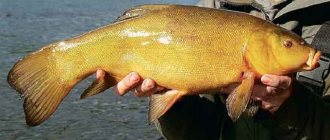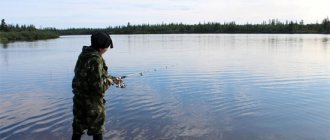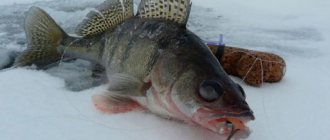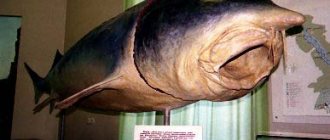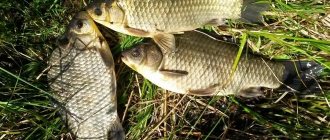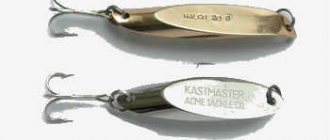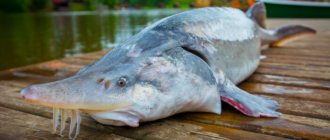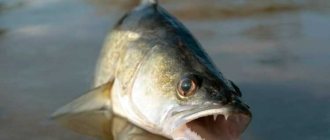Beluga fishing
Beluga is a fish of the sturgeon family, included in the Red Book. This is an anadromous fish that lives in the Caspian, Azov and Black Seas, from where it comes to spawn in the Volga, Ural, Kura, and Terek. In the past, when there were no hydroelectric power stations, fish rose very high in the Volga basin - to Tver and the upper reaches of the Kama, and in the Urals they spawned mainly in the lower and middle reaches. Beluga was also found along the Iranian coast of the southern Caspian Sea and spawned in the river. Gorgan. The Azov beluga enters the Don and Kuban. Previously, this fish rose high along the Don, but now it only reaches the Tsimlyansk hydroelectric station. The main part of the Black Sea beluga population, both in the past and now, lives in the northwestern part of the sea, from where it goes to spawn in the Danube, Dnieper and Dniester; single individuals used to enter (and perhaps are now entering) the Southern Bug.
Beluga was also found along the Crimean coast, near the Caucasian coast, where it sometimes went to spawn in Rioni, and along the Turkish coast, where it entered the Kyzylyrmak and Yesilirmak rivers to spawn. Along the Dnieper, large individuals (up to 300 kg) were sometimes caught in the area of rapids, and extreme occurrences were noted near Kyiv and higher: along the Desna, beluga reached the village of Vishenki, and along the Sozh - to Gomel, where in the 1870s. an individual weighing 295 kg (18 pounds) was caught. The main part of the Black Sea beluga goes to spawn in the Danube, where in the past this species was quite common and rose as far as Serbia, and in the distant past reached the city of Passau in eastern Bavaria. Along the Dniester, beluga spawning was observed near the city of Soroca in the north of Moldova and above Mogilev-Podolsky. Along the Southern Bug the fish rose to Vozne Seneca (northern Nikolaev region). Currently, the Black Sea beluga population is on the verge of extinction. Until the 70s. XX century Beluga was also found in the Adriatic Sea, from where it entered the Po River for spawning, but over the past 30 years it has never been seen here, and therefore the Adriatic population of beluga is currently considered extinct.
Beluga is a predator that feeds mainly on fish, which begins to lead a predatory lifestyle while still young in the river. In the sea, beluga also feeds mainly on fish (herring, sprat, gobies, etc.), but does not neglect shellfish. Even baby seals were found in the stomachs of Caspian beluga.
Beluga is a long-lived fish, reaching an age of 100 years. Unlike Pacific salmon, which die after spawning, beluga, like other sturgeon, can spawn many times in their lives. After spawning, it rolls back into the sea.
Beluga is one of the largest freshwater fish, reaching a mass of 1000 kg and a length of 4.2 m. There is information about a beluga caught in 1827 in the lower reaches of the Volga, which weighed 1.5 tons (90 pounds). In the Caspian Sea near the mouth of the Volga on May 11, 1922, a female weighing 1224 kg (75 pounds) was caught, with 667 kg on the body, 288 kg on the head and 146.5 kg on the eggs. Large specimens were also found in the southern part of the Caspian Sea. Thus, in 1836, a beluga weighing 960 kg (60 pounds) was caught near Krasnov on the Decoy Spit (modern Turkmenistan). Later, fish larger than a ton were no longer recorded, but in 1970 a case was described of catching a beluga weighing 800 kg in the Volga delta, from which 112 kg of caviar was extracted, and in 1989 a beluga weighing 966 kg and length 4.2 m (currently her stuffed animal is kept in the Astrakhan Museum)
The troubles of preserving a species
According to scientists, the beluga population has decreased by 90% in just the last 50 years. Based on this, based on such research data, we can assume that this is not a comforting result at all. Back in the middle of the last century, about 25 thousand individuals came to the Volga to spawn, and already at the beginning of this century this number decreased to 3 thousand.
Moreover, all these processes occur against the backdrop of enormous efforts that humanity is making to maintain the population of the species at least at the previous level. The main reasons for the reduction in numbers are as follows:
- Construction of hydroelectric power stations. The presence of huge dams does not allow fish to reach their natural spawning grounds. Such structures actually cut off the routes of beluga migration to the rivers of Austria, Croatia, Hungary and Slovakia.
- Actions of poachers. The high prices for the meat of this fish and its caviar are of interest to people who are accustomed to making money through illegal methods. Because they catch the largest individuals, which are capable of producing large offspring, the damage is very great. As a result of similar actions, the Adriatic population completely disappeared into the ground.
- Ecological violation. Because the beluga can live for a long time, during this time harmful substances accumulate in its body, which enter the water as a result of human economic activity, such as pesticides. This type of chemical affects the reproductive functions of fish.
We can only maintain hope that people will still be able to preserve this type of fish, which is distinguished by its enormous size, for their descendants.
Beluga caviar
Is it possible to catch
Catching, transporting, buying, selling and storing animals, including aquatic creatures listed in the Red Book of the Russian Federation, is prohibited by law . Article 258.1 of the Criminal Code of the Russian Federation provides for punishment for this in the form of compulsory labor for a period of up to 480 hours, corrective labor for a period of up to 2 years or forced labor for a period of up to 4 years, and a fine of up to 1 million rubles.
If a fisherman accidentally catches a rare fish listed in the Red Book on a fishing rod, in his hands, or in any other way, he is obliged to release it. If we are talking about reservoirs for sport fishing, then the same rule applies to them.
The caught fish must be released, as selling, storing or using it is prohibited by law.
The largest beluga
The largest representative of this species was caught back in 1922 in Russia in the Caspian Sea. Her weight was 1224 kilograms , and she also had caviar. And it is still a leader in the world.
When you look at the photograph confirming this fact, you simply cannot believe that this is true. This fish looks more like a monster.
There are several more examples confirming the enormous size of this fish. Anyone can see this giant fish in the Kazan museum. She was stuffed. When she was caught, her weight reached a whole ton, and her size was 4.17 meters.
Another copy can be seen in the Astrakhan museum. This fish was caught in the Volga and reached its maximum weight - a ton, or more precisely, 966 kilograms. The length of this beluga was slightly less than six meters. According to sources, this fish was caught by poachers, the eggs were gutted from it, and the fish itself was thrown away. Fearing that they might be imprisoned, they reported this discovery to the museum staff. So this fish turned into a giant stuffed animal.
Reasons for confusion
You can often find people who confuse beluga with other types of fish. Why? And it’s all very simple: the word “beluga” used to refer to whales. Everyone knows that whales are undoubtedly larger than beluga. As a result, incorrect facts appeared that a beluga weighing about two tons was caught. Perhaps it was just a whale, also called a beluga whale. But beluga whales are distinguished not only by their enormous mass, but also by the fact that they can sing. Such confusion also occurs abroad. There, beluga is designated by a word such as sturgeon. In this regard, when catching large fish of the sturgeon family, it is classified as beluga.
Where does the beluga live?
Beluga is found mainly in the basins of the Caspian and Black Seas, and sometimes in the Adriatic Sea. To spawn, fish go to rivers that flow into the listed seas - Volga, Ural, Kura, Terek, Don. In the Black Sea, this fish is found off the coast of Yalta, from where it swims to the Dnieper, Danube, and Dniester.
From the coast of Turkey it moves to the Kyzylyrmak and Yesilirmak rivers. But everywhere it does not rise above the built hydroelectric power stations. Due to the massive construction of hydroelectric power stations, spawning sites were inaccessible, which negatively affected the population - because of this, the species is listed in the Red Book.
The species' habitat is limited to the northern hemisphere (Eurasia, North America). A relative of the beluga, the kaluga (Huso dauricus), lives in the Amur River. And although both species belong to the same genus, modern scientists doubt whether they are related.
Beluga population protection
Due to various reasons, this type of fish has significantly reduced its population and may disappear. Therefore, the beluga is listed in the Red Data Books of all countries in whose water bodies it is still found. The fish is prohibited from catching according to the relevant Fishery Rules. It is in the Red Book of the International Union for Conservation of Nature.
Beluga fishing is only possible with a license. It indicates the number of fish that can be caught and their size.
Illegal fishing of beluga is punishable by a fine. It is different in different countries. In Russia, for each individual it is 12.5 thousand rubles. In addition, a number of fines are levied; for example, up to 5 thousand rubles. for illegal fishing and others.
There is also criminal liability for illegal beluga fishing. Depending on the damage caused, this may include community service or imprisonment for up to 5 years.
What do belugas bite on?
Like all sturgeons, the beluga is covered with durable bony plates, has an asymmetrical, shark-like tail and antennae on a long, elongated snout. This is the only sturgeon species that actively eats other fish. The adult sturgeon has few natural predators. However, due to its caviar, the cost of which can reach up to $8,000 per 1 kg, it is actively caught by poachers. All sturgeons are also valuable commercial fish.
Licenses for catching beluga sturgeon as an object of sport fishing are issued in specially designated places in the Caspian Sea from April to May. The fisherman will need a motor boat with special equipment. Beluga feeds 3–5 km from the coastline. Its main food is in the coastal zone. Fishermen determine its feeding areas by the presence of shell rock at the bottom, near which the main prey is located.
In terms of feeding habits, beluga differs from other sturgeons, which feed on invertebrate animals while swimming along the bottom. In the Black Sea they feed on such types of fish as flounder, gobies, and anchovies. In the Caspian Sea - Caspian roach, herring, and local gobies. The species does not gather in flocks, but disperses. In addition, the predator can endure a long period of starvation, so it is not so easy to catch.
Given that the beluga is a predator, the bait will require its natural prey. And it should not be just a piece of fillet, but a fish along with its scales. Length - up to 15 cm. The natural shine of the scales in the sun attracts the attention of a predator. It is recommended to change the bait after 3 throws.
Natural enemies of the beluga
Due to its size and predatory lifestyle, the beluga has virtually no enemies in its natural habitat. No sea predator ever hunts it. The exception is fry and caviar, which become a source of food for many marine inhabitants. It is noteworthy that the beluga is one of its most important enemies. This is due to the fact that cannibalism is very common among this breed of predators. They eat their own relatives and caviar, and in fairly large quantities.
One of the main enemies and practically the only enemies of the sea predator is man. Previously, in many regions, in particular on the Volga, 1.5-2 thousand tons of this valuable fish were caught during the spawning period. In many regions today it is bred for industrial sale, since caviar is considered a very expensive and elite delicacy. It has excellent taste.
Its calorie content is higher than the calorie content of the fish meat itself. Beluga caviar is very rich in natural protein, which helps maintain youthful skin. However, breeding it is not always successful and in large quantities. In this regard, poaching is very common in many regions, especially during the spawning season, when fish gather in large quantities at river mouths.
Beluga fishing technique
For equipment, a fisherman needs a fishing rod with a fishing line that can withstand a weight of 200 kg to 1 ton. Although the maximum weight of a female caught on the Volga in 1989 was 966 kg, you need to be prepared to lift a lot of weight. The beluga will bite just like an ordinary fish. You need to wait for light twitches of the rod, and when it bites more powerfully, you can hook. Then the fish will actively “roll” the boat for several hours until it gets tired and floats up.
Given the weight, to lift the fish you may need a mesh lift, which is included in the equipment of the fishing boat. Even when lifted aboard, the fish remains dangerous, as it can sweep fishermen into the water with a blow of its tail. If the fishermen have caught the prey, it is turned over on its back, measured, weighed and released into the water, since the goal of sport fishing has been achieved. As for industrial fishing, it is not carried out on the territory of the Russian Federation.
Video: catching beluga
Considering the weight of the prey, only experienced fishermen can afford sport fishing. At the same time, they will definitely need a powerful reel, circle hooks, a fishing permit and a huge supply of patience.
Interesting facts about beluga
- Beluga can live more than 100 years, which is why it is considered one of the longest-living fish in the world.
- Parents do not care about their offspring. In addition, they do not mind feasting on their relatives.
- When the beluga goes to spawn, it jumps high out of the water. This is still an unsolved mystery.
- The beluga, like the shark, has no bones, and its skeleton is made up of cartilage, which becomes harder and stronger over the years.
- It is possible to find quite a lot of eggs in the female. Thus, an individual weighing about 1200 kg can contain up to 150 kg of caviar.
- In the Amur River basin there is a similar species - kaluga, which can be about 5 meters in length and weigh up to 1000 kg. Attempts by scientists to cross kaluga and beluga ended in nothing.
Sport fishing for beluga. Giant beluga.
Beluga
is a freshwater predatory “monster”. In the nineteenth century, according to unverified data, a huge specimen of this fish species was caught, weighing more than two thousand kilograms and nine meters long. This is the largest fish on the entire planet Earth, living in fresh water. In the last century, there are indeed officially registered cases of catching giants reaching a weight of one and a half tons and a length of five hundred centimeters, and the museums of Astrakhan and Tatarstan have ton specimens of stuffed fish of these fish, reaching more than four meters in length. As soon as the sun warms up the river water in April-May, belugas from the seas rush to enter the rivers to reproduce their own kind; from September to October, belugas will enter the rivers to spawn before winter. The history of past centuries tells about the industrial fishing of beluga in Russia alone, amounting to tens of thousands of tons of fish caught per year. But the widespread industrialization of the economies of states, namely the construction of dams for hydroelectric power stations in the spawning grounds of beluga, led to a catastrophic decrease in the population of this fish. Today Beluga as an endangered species is protected by law and is a fish listed in the Red Book of Russia and the IUCN.
Giant size sturgeon
Beluga itself is a specimen of fish from the sturgeon family of gigantic size. Its main food is fish - roach, gobies, herring. Beluga fish is found mainly in warm seas such as the Caspian, Adriatic, Black, Azov and White seas. At approximately twenty-three years of age, the female beluga can already go to spawn and move to the nearest freshwater rivers. The life expectancy of this fish on average reaches fifty to sixty years; sometimes the fish lives up to a hundred years. An adult specimen grows up to four and a half meters in length and weighs about a ton.
Uncontrolled fishing of beluga has now led to a sharp decline in its population. Today it is caught mainly for the purpose of artificial breeding. Beluga fishing is classified as entertainment, as well as for scientific purposes and artificial propagation of this species.
Sport fishing for beluga
mainly produced in the spring, from April to the month of May, with a license for sport fishing in a special place in the Caspian Sea. Having agreed with specialists in the beluga fishery on a fishing date, armed with powerful fishing gear and specially equipped for fishing, boats and motorboats go out to sea three or five kilometers from the shore to the feeding grounds of this giant fish. As a rule, it is not possible to determine the fishing location in the sea by eye, so the beluga fishing specialists accompanying the fishermen use a large pole to examine the surface of the bottom, find shell rock, drop anchors and the beluga fishing begins.
Beluga
Beluga is the largest freshwater fish of the sturgeon order. In some cases, its weight reaches 1000 kilograms, and there are cases when a beluga over 1000 kilograms was seen and caught. And the body length of an adult beluga ranges from 3 to 4 and a half meters. The longest recorded length of this Bala fish is more than 5 meters.
The body of the beluga has a thick cylindrical shape and is covered with bony scutes. But relative to the body and head, it is short and pointed towards the end. The mouth is large almost the entire width of the head and is surrounded by a thick, fleshy lip. The back and sides of the beluga are ash-gray in color, and the belly is lighter - grayish-white. The beluga's nose has a yellowish tint.
The Beluga's habitat is considered to be the Black and Caspian Seas, as well as the rivers flowing into these seas. These are rivers such as the Volga, Don, Kura, Kuban, Ural and Danube. This giant was also spotted several times in the Adriatic and Mediterranean seas. So the beluga can also enter these areas. By the way, the sea is the beluga’s permanent residence, and it migrates to rivers for only one purpose – spawning. Moreover, the more spawning belugas, the further along the river they go. At this time, local residents of the rivers catch this freshwater giant of the sturgeon genus.
Some belugas may remain in the river over the winter, but only if they are ready to breed in the spring. That is, sexually mature individuals remain to spend the winter in the river in order to spawn in the spring. Another feature of beluga females is that they reproduce, that is, they have the ability to spawn, only after a year. Old individuals that are no longer capable of reproducing offspring can also remain in the river for the winter. The larger the fish, the deeper the place in the river it occupies for wintering.
They remain to winter in the lower reaches of the Volga, Ural and some other rivers, but belugas do not winter in the rivers of the Black Sea basin. Since a certain number of belugas remain to winter in the rivers, fishing for them is carried out both in summer and winter. During the winter period, the beluga leads a sedentary lifestyle and hibernates at the bottom of rivers. However, on navigable rivers this sleep is disturbed by the horns of ships and their engines. Based on this, the most peaceful sleep for belugas is in the Ural River, which is not navigable. During the winter, the body of the beluga is covered with a thick layer of mucus, which is called slen. It serves as a kind of fur coat for the fish.
In winter, the fish practically does not feed, since there is still undigested food in its stomach. However, sometimes the beluga can eat small crustaceans and other shells. This continues throughout December and January. The beluga begins to feed and look for food in the month of February, when the ice begins to gradually melt. The beluga's diet during this period includes shells, crustaceans, and other fish, mainly roach. You can also see ducks or newborn baby seals in the beluga's stomach during this period. But by spring, beluga completely switches to its favorite food during this period - roach, which migrates from the sea to rivers to spawn in large schools. Following the roach, the beluga also goes to spawn.
When the ice melts, beluga whales like to swim on the surface of the sea, lightly touching the ice with their backs. Belugas are one of the first red fish to begin their spring migration to spawn. Meanwhile, the beluga, which remained to winter, is forced to spawn higher than those that have just arrived from the sea to spawn. This explains the fact that larger beluga whales are found higher up the river. It is also known that the more mature and larger female beluga spawns a little later, as it takes her longer for the eggs to mature.
Many scientists claim that some female belugas spawn in the sea. However, the favorite place for laying eggs is a deep-water river with a fast current and a rocky or pebble bottom. These are the spawning areas that belugas prefer. If the fish does not find a suitable place to spawn, it will be forced to replace it with others. In this case, snags on the bottom and coastal zones can become a spawning site. Otherwise, if the female does not find a suitable place to lay eggs, then she simply will not throw them, and the eggs will gradually dissolve inside her body. This fact explains why more experienced and sexually mature females remain to spend the winter in rivers, thereby choosing a place for spawning in the spring. So that other females do not have time to occupy them.
The exact date when beluga spawning occurs is not known. What is known is that this process is quite long and can take up to one month. According to preliminary data, spawning may take place among belugas in May-June. How exactly spawning occurs in belugas is also not fully understood. Many argue that during spawning, females jump out of the water to facilitate the release of eggs. Others notice that females rub against stones and thereby help the eggs release. There is another opinion about the friction of females on stones. Many assume that they do this in order to form a nest for laying. When the eggs are already in the right place, the male rubs against the female so that this action helps the formation and release of milk, which is intended to fertilize the eggs.
Beluga caviar is quite large and is the size of a full pea. Caviar throwing occurs in several passes. According to observations, one female can lay about 320 kilograms of eggs at a time, regardless of her age and body size. This fact indicates that beluga is one of the most prolific fish.
With such fertility, the number of belugas should be much higher than sturgeon, stellate sturgeon and other crane fish, but in reality it turns out differently. This number is due to a number of factors. The first is that females do not always find places to lay eggs and they are absorbed in their bodies. The second factor is natural. A large amount of caviar disappears, is crushed between stones, carried away by the current, and becomes food for other fish. But even if the fry managed to survive and get out, they are in danger of the surrounding reality. Many fry can also be crushed by rocks, carried away by currents, or eaten by other water inhabitants. Small fish often end up in fishermen's nets without ever reaching sexual maturity. In light of these events, we can say that out of 100 thousand beluga eggs, only one survives and gets a start in life. But dangers await him on his way to the sea.
Unfortunately, it is not known for certain how long the eggs take to mature and when the fry hatch from them. We can only draw an analogy with other representatives of the sturgeon order and say that the ripening time for caviar is approximately 10 days, after which small beluga whales are born. They live in the spawning area for about another month, and then go free swimming. This happens somewhere in late summer and early autumn. Little beluga whales migrate into a sea full of dangers and surprises. At first, beluga whales feed on small crustaceans and shells when they first enter the sea. And then gradually fish and mainly roach are introduced into the diet.
In the middle of summer in July, you can meet hungry belugas in the river, eating everything they see. After spawning, they are very hungry and are always busy looking for food. They suck in food with their mouths, and if there is food at the bottom, they first create a whirlpool to lift it up for easier consumption. At this time, beluga is readily caught by various animals. At this time, you can find old belugas in the sea, which, according to eyewitnesses, eat not only edible, but also non-edible objects, such as driftwood and stones. Old belugas can be distinguished by their appearance. They are large, the head is also large, and the body is emaciated. In ancient times, such belugas, if caught, were not eaten.
Beluga fishing is carried out mainly in the spring, when they actively migrate to spawn. Basically, beluga fishing is sea fishing, which takes a very long time - from morning until evening. Beluga is caught on a particularly strong bottom using a thick and durable fishing line, a reliable, large hook and a heavy weight that acts as a sinker. You should fish with bait, which is most often used as a roach. But you can also catch other fish, for example, asp or herring.
If you fish at sea, you should swim approximately 3 kilometers from the shore. It is believed that it is at this distance that the beluga feeds. It is difficult to accurately determine and find the place where beluga feeds and stays. But experienced fishermen know how to do it. They use a special pole with which they explore the bottom. It should be solid. The hard bottom indicates that there is a lot of shell rock there, which means it is a potential feeding area for belugas. Its depth is approximately 4 meters. They are caught in the open sea on specially equipped boats or cutters. Fish or its fillets are used for bait. It can be roach, asp, herring or bream whole or fillet. It is only necessary to leave the scales so that they shine, since the beluga does not have good eyesight. If you have already made a couple of casts of bait, then it should be changed.
The most fascinating thing about catching belugas is casting and waiting for the bite. At first there will be several short bites, and it may seem that a small fish has been caught on the hook, but you need to wait. Then a short pull will follow - this is a signal, but you need to be persistent and wait until the beluga completely swallows the bait. This will be clear immediately - there will be a sharp jerk under the water and the fishing line will stretch. At this moment you can hook, but not cut, as the line may not hold up and may break due to the weight of the fish. The fish should be removed carefully. Although there are cases where a beluga led fishermen for hours until they were able to pull it out. Next comes the hardest part - dragging the fish onto the boat. Here you need to be extremely careful, because the fish is very large and heavy and it may happen that the fisherman himself ends up overboard before the fish gets on the ship. It is tedious to drag in a beluga, turning it belly up. As soon as you succeed, the fish will stop resisting.
Beluga fishing is carried out in the spring, usually in April-May. However, it is worth remembering that beluga is an object of sport fishing. You will not be able to take the trophy with you. The fish will have to be released, but before that you can take a photo with it as a souvenir.
Beluga meat is very tasty and nutritious, which has made this fish a valuable commercial item. And not only beluga meat is valued. Its caviar is one of the most delicious among black caviar. Due to its taste qualities, the fish was caught for food and caviar, which led to its almost complete disappearance. The fish is eaten almost completely, not a single piece is wasted. Even the beluga's entrails are not thrown away, but used for their intended purpose. For example, the beluga swim bladder is dried and a special glue is made from it, which is used to clarify white wines and is also used for other purposes.
But today, beluga meat, and even more so its caviar, is extremely difficult to obtain, since commercial fishing is prohibited due to its disappearance and decline in numbers.
